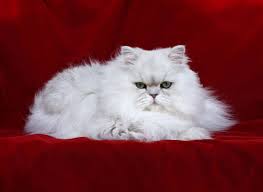
Persian (traditional)
Conditions of detention
Traditional Persians thrive in calm and comfortable indoor environments. They enjoy having cozy spots to relax and prefer a stable, quiet atmosphere where they can be part of family activities.
Useful Fact:
Traditional Persians are known for their gentle and affectionate nature. They enjoy companionship and will often seek out their owners for attention and cuddles, making them excellent companions for those seeking a loving pet.
Nutrition and diet
Traditional Persians require a balanced diet rich in high-quality protein to support their muscular build and maintain their luxurious coat. A combination of wet and dry food ensures they receive necessary nutrients and hydration. Monitoring their diet is essential to prevent obesity and related health issues.
Useful Fact: Including omega-3 and omega-6 fatty acids in their diet helps maintain their skin and coat health.
Health
Traditional Persians are generally healthier than their modern counterparts due to their less extreme facial structure. However, they can still be prone to genetic conditions like polycystic kidney disease (PKD) and hypertrophic cardiomyopathy (HCM). Regular veterinary check-ups are crucial to monitor their health.
Useful Fact: Genetic testing can help identify the risk of hereditary conditions, ensuring timely management and care.
Grooming and care
Their long, thick coat requires daily grooming to prevent matting and tangles. Regular brushing helps reduce shedding and maintain coat health. Eye cleaning is also necessary to manage tear staining, common in this breed.
Useful Fact: Despite their high-maintenance grooming needs, many Traditional Persians enjoy the grooming process, which can strengthen the bond with their owners.
Education and training
Traditional Persians are intelligent and can be trained to follow basic commands and use a litter box efficiently. They respond well to positive reinforcement techniques, such as treats and gentle praise.
Useful Fact: These cats can learn to enjoy grooming sessions, making it easier to maintain their coat and overall hygiene.
Toys and entertainment
These calm and relaxed cats enjoy gentle play with soft toys, feather wands, and interactive play sessions with their owners. They appreciate cozy resting places where they can lounge and observe their surroundings.
Useful Fact: Traditional Persians often enjoy interactive playtime, which helps keep them mentally stimulated and engaged.
Safety
Traditional Persians should be kept indoors to protect them from potential dangers such as traffic, predators, and extreme weather conditions. Microchipping and providing identification tags are essential for their safety.
Useful Fact: Their calm and gentle nature makes them well-suited for indoor living, where they feel safe and secure.
Accessories
Essential accessories for Traditional Persians include a comfortable bed, high-quality scratching posts, a variety of toys, and a sturdy cat carrier for travel. Regular grooming tools like brushes and combs are also important.
Useful Fact: Investing in high-quality grooming tools can make daily grooming sessions more effective and enjoyable for both the cat and the owner.
Socialization
Traditional Persians are sociable and thrive on human interaction. They get along well with children and other pets, making them excellent family companions. Early socialization helps them become well-adjusted and confident adults.
Useful Fact: Their affectionate nature often leads them to seek out attention and companionship from their owners.
Travel and Transportation
When traveling, use a secure and comfortable cat carrier. Familiarizing your Traditional Persian with the carrier before trips can reduce stress. Ensure they have access to water and take breaks during long journeys.
Useful Fact: Bringing familiar items like a favorite blanket or toy can help reduce anxiety during travel.
Behavior and psychology
Traditional Persians are known for their calm, gentle, and affectionate nature. They enjoy a relaxed lifestyle and form strong bonds with their owners. Their serene demeanor makes them excellent pets for quiet households.
Useful Fact: Traditional Persians often prefer a predictable routine and can become stressed by sudden changes in their environment.
Legal aspects
Ensure your Traditional Persian is up-to-date on vaccinations and registered according to local regulations. Spaying or neutering is recommended to prevent unwanted litters and reduce certain health risks.
Useful Fact: Many regions require cats to be microchipped and wear identification tags, which can help in reuniting lost pets with their owners.


